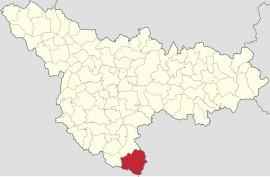Jamu Mare
Jamu Mare | |
|---|---|
 The Roman Catholic church in Jamu Mare | |
 Location in Timiș County | |
| Coordinates: 45°15′N 21°25′E / 45.250°N 21.417°E | |
| Country | Romania |
| County | Timiș |
| Government | |
| • Mayor (2020–2024) | Petre Gagea-Neaga[1] (PNL) |
Area | 207.11 km2 (79.97 sq mi) |
| Population (2021-12-01)[3] | 2,748 |
| • Density | 13/km2 (34/sq mi) |
| Time zone | EET/EEST (UTC+2/+3) |
| Postal code | 307230–307234 |
| Vehicle reg. | TM |
| Website | www |
Jamu Mare (Hungarian: Nagyzsám; German: Freudenthal or Großscham; Serbian: Велики Жам, romanized: Veliki Žam) is a commune in Timiș County, Romania. It is composed of five villages: Clopodia, Ferendia, Gherman, Jamu Mare (commune seat), and Lățunaș.
Name
[edit]In Romanian, the name means "Greater Jam/Žam". On the other side of the border, in Serbia, there is a village called Mali Žam ("Smaller Jam/Žam").
History
[edit]Jamu Mare was first documented in 1335, under the name Jam.[4] In 1370 it belonged to Krassó County and was called Suma.[5] In Marsigli's notes from 1690–1700 it is called Seham and appears with 67 houses.[5] Between 1730–1740 a plague epidemic decimated the population. Thus, with the third German colonization, a new locality was established a little further west of the old settlement. Then 152 houses were built. In 1786, thirty families settled here, and in the autumn of the next year the rest of the newcomers. It was then called Freudenthal. The administration moved the Romanians to the border area, and the houses were assigned to the Germans. At the end of the 18th century, Hungarian statistician Elek Fényes recorded that the village called Nagy-Zsám had a population of 1,562 and belonged to the nobleman László Karácsonyi.[6] In 1807 another wave of German colonists from Torontál County settled here. 1809 is considered the year of the effective establishment of the new locality, on the current location. The old Freudenthal colony was gradually abandoned by the Germans, who preferred to move to Jamu Mare, and in 1893, the territory of the colony was incorporated into the current commune.[6]
Demographics
[edit]Ethnic composition (2011)[7]
Religious composition (2011)[8]
Jamu Mare had a population of 2,971 inhabitants at the 2011 census, down 11% from the 2002 census. Most inhabitants are Romanians (88.22%), larger minorities being represented by Hungarians (3.94%) and Roma (2.79%). For 3.3% of the population, ethnicity is unknown.[7] By religion, most inhabitants are Orthodox (77.25%), but there are also minorities of Roman Catholics (10.91%), Greek Catholics (3.87%) and Baptists (2.56%). For 3.3% of the population, religious affiliation is unknown.[8]
| Census[9] | Ethnic composition | ||||||
|---|---|---|---|---|---|---|---|
| Year | Population | Romanians | Hungarians | Germans | Roma | Czechs | Slovaks |
| 1880 | 6,978 | 3,127 | 581 | 2,750 | – | – | 425 |
| 1890 | 7,727 | 3,175 | 813 | 3,162 | – | – | 15 |
| 1900 | 8,174 | 3,535 | 950 | 3,074 | – | – | 20 |
| 1910 | 8,277 | 3,661 | 1,097 | 2,898 | – | – | 70 |
| 1920 | 3,717[a] | 2,415 | 436 | 458 | – | – | – |
| 1930 | 7,513 | 3,656 | 754 | 2,527 | 114 | – | 406 |
| 1941 | 7,662 | 3,711 | 914 | 2,433 | – | – | – |
| 1956 | 6,283 | 3,958 | 738 | 1,311 | – | 234 | 20 |
| 1966 | 5,907 | 3,932 | 621 | 1,079 | 71 | 153 | 12 |
| 1977 | 4,697 | 3,315 | 468 | 686 | 103 | 95 | 6 |
| 1992 | 3,487 | 2,923 | 320 | 114 | 55 | 54 | 5 |
| 2002 | 3,327 | 2,893 | 243 | 63 | 73 | 35 | 3 |
| 2011 | 2,971 | 2,621 | 117 | 29 | 83 | 13 | – |
Natives
[edit]- Ioachim Miloia (1897 – 1940), painter, historian, and academic
Transport
[edit]
Jamu Mare is now a railway terminus, but between 1925 and 1930, trains would pass through it all the way to Vršac in present-day Serbia. The rail station is currently closed, without service.
Four county roads run through the commune.
Notes
[edit]- ^ Data on the populations of Jamu Mare and Lățunaș missing
References
[edit]- ^ "Results of the 2020 local elections". Central Electoral Bureau. Retrieved 16 June 2021.
- ^ "Primăria Jamu Mare". Ghidul Primăriilor.
- ^ "Populaţia rezidentă după grupa de vârstă, pe județe și municipii, orașe, comune, la 1 decembrie 2021" (XLS). National Institute of Statistics.
- ^ Pesty, Frigyes (1884). Krassó vármegye története (PDF). Vol. II. Budapest: Athenaeum R. Társ. Könyvnyomdája.
- ^ a b Szabó, M. Attila (2003). Erdély, Bánság és Partium történeti és közigazgatási helységnévtára. Miercurea Ciuc: Pro-Print Kiadó.
- ^ a b "Fișa Primăriei comunei Jamu Mare". Consiliul Județean Timiș.
- ^ a b "Tab8. Populația stabilă după etnie – județe, municipii, orașe, comune". Institutul Național de Statistică. Archived from the original on 2016-01-18. Retrieved 2021-10-25.
- ^ a b "Tab13. Populația stabilă după religie – județe, municipii, orașe, comune". Institutul Național de Statistică. Archived from the original on 2020-08-07. Retrieved 2021-10-25.
- ^ Varga, E. Árpád. "Temes megye településeinek etnikai (anyanyelvi/nemzetiségi) adatai 1880-2002" (PDF). Archived from the original (PDF) on 2007-06-10. Retrieved 2021-10-25.


